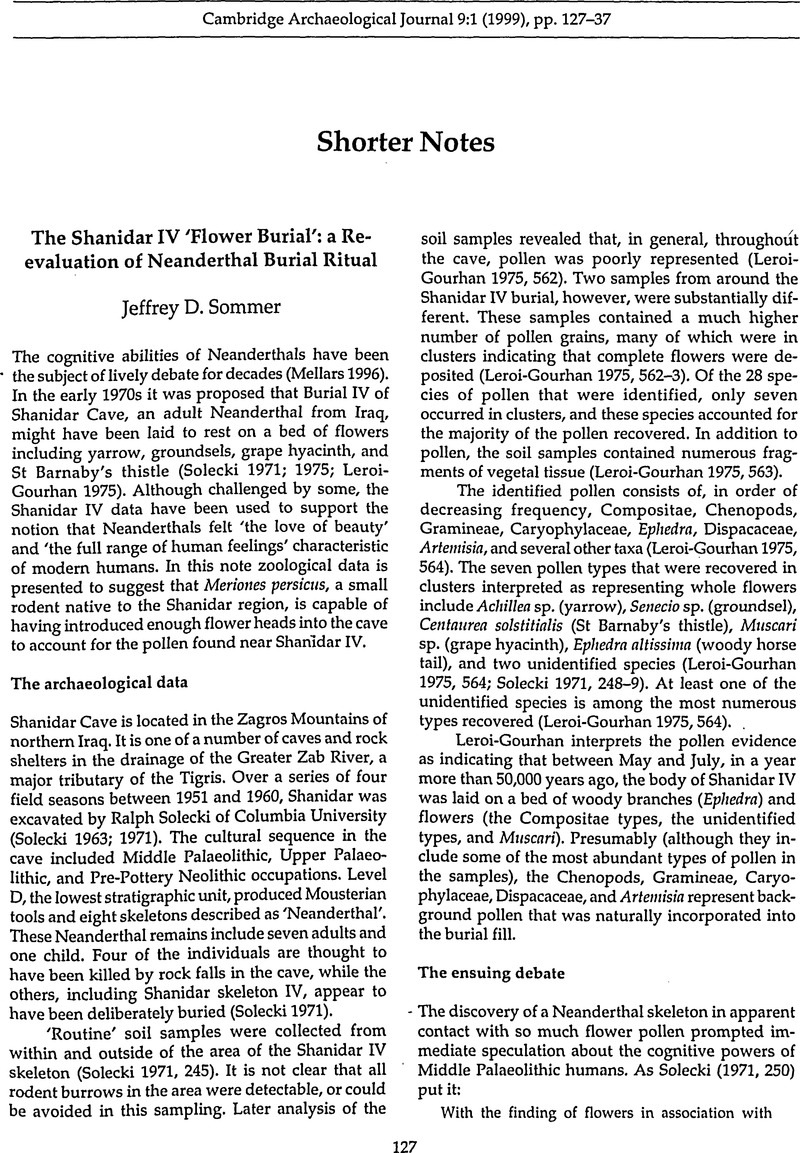Crossref Citations
This article has been cited by the following publications. This list is generated based on data provided by Crossref.
Merlin, M. D.
2003.
COVER ARTICLE: Archaeological Evidence for the Tradition of Psychoactive Plant Use in the Old World.
Economic Botany,
Vol. 57,
Issue. 3,
p.
295.
Haviland-Jones, Jeannette
Rosario, Holly Hale
Wilson, Patricia
and
McGuire, Terry R.
2005.
An Environmental Approach to Positive Emotion: Flowers.
Evolutionary Psychology,
Vol. 3,
Issue. 1,
Weiss, Ehud
Kislev, Mordechai E.
Simchoni, Orit
Nadel, Dani
and
Tschauner, Hartmut
2008.
Plant-food preparation area on an Upper Paleolithic brush hut floor at Ohalo II, Israel.
Journal of Archaeological Science,
Vol. 35,
Issue. 8,
p.
2400.
2009.
Darwin en tête !.
p.
309.
Šarić-Kundalić, Broza
Dobeš, Christoph
Klatte-Asselmeyer, Valerie
and
Saukel, Johannes
2010.
Ethnobotanical study on medicinal use of wild and cultivated plants in middle, south and west Bosnia and Herzegovina.
Journal of Ethnopharmacology,
Vol. 131,
Issue. 1,
p.
33.
Nadel, Dani
Danin, Avinoam
Power, Robert C.
Rosen, Arlene M.
Bocquentin, Fanny
Tsatskin, Alexander
Rosenberg, Danny
Yeshurun, Reuven
Weissbrod, Lior
Rebollo, Noemi R.
Barzilai, Omry
and
Boaretto, Elisabetta
2013.
Earliest floral grave lining from 13,700–11,700-y-old Natufian burials at Raqefet Cave, Mt. Carmel, Israel.
Proceedings of the National Academy of Sciences,
Vol. 110,
Issue. 29,
p.
11774.
D’Anastasio, Ruggero
Wroe, Stephen
Tuniz, Claudio
Mancini, Lucia
Cesana, Deneb T.
Dreossi, Diego
Ravichandiran, Mayoorendra
Attard, Marie
Parr, William C. H.
Agur, Anne
Capasso, Luigi
and
Frayer, David
2013.
Micro-Biomechanics of the Kebara 2 Hyoid and Its Implications for Speech in Neanderthals.
PLoS ONE,
Vol. 8,
Issue. 12,
p.
e82261.
2013.
Understanding Death.
p.
49.
Schlager, Stefan
and
Wittwer-Backofen, Ursula
2013.
Handbook of Paleoanthropology.
p.
1.
Buck, Laura T.
and
Stringer, Chris B.
2014.
Having the stomach for it: a contribution to Neanderthal diets?.
Quaternary Science Reviews,
Vol. 96,
Issue. ,
p.
161.
Deforce, Koen
Van Hove, Marie-Laure
and
Willems, Didier
2015.
Analysis of pollen and intestinal parasite eggs from medieval graves from Nivelles, Belgium: Taphonomy of the burial ritual.
Journal of Archaeological Science: Reports,
Vol. 4,
Issue. ,
p.
596.
Schlager, Stefan
and
Wittwer-Backofen, Ursula
2015.
Handbook of Paleoanthropology.
p.
1007.
Premathilake, R.
and
Seneviratne, S.
2015.
Cultural implication based on pollen from the ancient mortuary complex in Sri Lanka.
Journal of Archaeological Science,
Vol. 53,
Issue. ,
p.
559.
Iriarte-Chiapusso, María-José
Arrizabalaga, Alvaro
and
Cuenca-Bescós, Gloria
2015.
The vegetational and climatic contexts of the Lower Magdalenian human burial in El Mirón Cave (Cantabria, Spain): implications related to human behavior.
Journal of Archaeological Science,
Vol. 60,
Issue. ,
p.
66.
Guerra-Doce, Elisa
2015.
The Origins of Inebriation: Archaeological Evidence of the Consumption of Fermented Beverages and Drugs in Prehistoric Eurasia.
Journal of Archaeological Method and Theory,
Vol. 22,
Issue. 3,
p.
751.
Fiacconi, Marta
and
Hunt, Chris O.
2015.
Pollen taphonomy at Shanidar Cave (Kurdish Iraq): An initial evaluation.
Review of Palaeobotany and Palynology,
Vol. 223,
Issue. ,
p.
87.
Guerra-Doce, Elisa
2015.
Psychoactive Substances in Prehistoric Times: Examining the Archaeological Evidence.
Time and Mind,
Vol. 8,
Issue. 1,
p.
91.
Bockarova, Mariana
2016.
Does one truly need to belong?: A case for the need to meaningfully exist.
Semiotica,
Vol. 2016,
Issue. 210,
p.
251.
Shipley, Gerhard P.
and
Kindscher, Kelly
2016.
Evidence for the Paleoethnobotany of the Neanderthal: A Review of the Literature.
Scientifica,
Vol. 2016,
Issue. ,
p.
1.
Brown, Tony
2016.
Handbook of Missing Persons.
p.
319.



